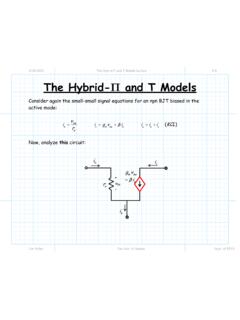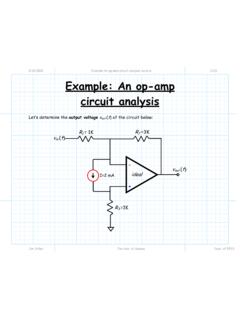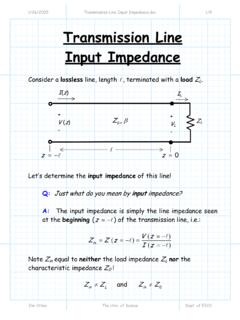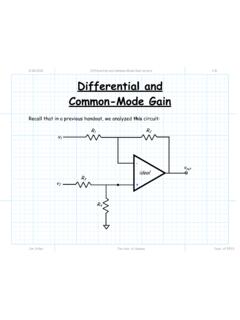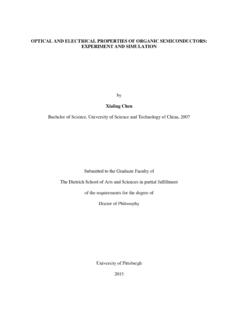Transcription of OPTICAL PROPERTIES OF III-NITRIDE SEMICONDUCTORS …
1 OPTICAL PROPERTIES OF III-NITRIDE SEMICONDUCTORS AND THE applications IN ALL- OPTICAL SWITCHING By Yueting Wan (Telecommunications), Asian Institute of Technology, 1997 (Physics), University of Memphis, 2000 Submitted to the Department of Electrical Engineering and Computer Science and the Faculty of the Graduate School of the University of Kansas In partial fulfillment of the requirements for the degree of Doctor of Philosophy _____ Chairperson Committee members _____ _____ _____ _____ Date defended: _____ ii The Dissertation Committee for Yueting Wan certifies that this is the approved version of the following dissertation: OPTICAL PROPERTIES OF III-NITRIDE SEMICONDUCTORS AND THE applications IN ALL- OPTICAL SWITCHING Committee: _____ Chairperson _____ _____ _____ _____ Date approved: _____ iii To My Parents and Siblings iv ACKNOWLEDGEMENTS I would like to express my gratitude to Dr.
2 Rongqing Hui, my committee chair, for his guidance throughout this research work and for his precious advice and support during my graduate studies here at the University of Kansas. His encouragement and full support led me to the success of this work. I have also been able to learn a lot from him about being a better researcher. It was an absolute pleasure working for him the past five years. I would also like to thank other members of my committee, Dr. Christopher Allen, Dr. Victor Frost, Dr. Hongxing Jiang and Dr. Karen Nordheden, for serving on my dissertation committee and giving me invaluable suggestions through out my research work. Also, I would like to express my thanks to the National Science Foundation for providing the financial support for my research work. Finally, I would like to thank my family and friends for their patience and encouragement throughout the work of my dissertation.
3 The support from them makes this work successful. v ABSTRACT The goal of this research was to build an N N all- OPTICAL WDM switch, which is indispensable for the next-generation of all- OPTICAL packet-switched networks. We started from the basic concepts of telecommunication network architectures, OPTICAL networks, WDM network elements and basic components in OPTICAL networks. We focused on the principles and applications of OPTICAL couplers, Mach-Zehnder Interferometers (MZI), arrayed waveguide gratings (AWG), and some switch architectures and techniques that have helped in the design of the OPTICAL switch. Based on the AWG principle, we derived a general design rule for constructing an N-interleaved AWG (N-IAWG), and proposed a 1 N WDM switch consisting of two N-IAWGs and a phase shifter array. We then simplified the structure by using only one N-IAWG with total reflection implemented at the end of each phase shifter.
4 The simplified structure significantly reduced the device size and relaxed the design tolerance. This suggests that it could be used as the fundamental building block to construct non-blocking N N all- OPTICAL WDM switches with Spanke architecture. The feasibility of the proposed OPTICAL switch depends on the refractive index tuning in the phase shifter array, which can be realized through the carrier-induced index tuning of SEMICONDUCTORS . We proposed to use III-NITRIDE SEMICONDUCTORS due to vi their unique characteristics, and presented a theoretical study of carrier-induced refractive index change in GaN in the infrared wavelength region. Calculations verified that the magnitude of carrier-induced refractive index change is high enough for the application to the proposed OPTICAL switch. We then prepared various devices in GaN/AlGaN material and characterized their OPTICAL PROPERTIES in the 1550 nm wavelength region experimentally.
5 We measured the refractive indices and the impact of Al concentrations. We also measured the birefringence of the GaN waveguides, which helped understand the polarization effect in the devices and would help design polarization independent OPTICAL waveguides. Among the devices we prepared, there was an eight-wavelength AWG, which was the first AWG in GaN/AlGaN material. The performance of the AWG agreed well with our design expectations and may be a foundation for the application in OPTICAL switches. vii TABLE OF CONTENTS 1. 1 2. OPTICAL Networking and 4 4 Telecommunications Network 4 OPTICAL 8 Multiplexing Techniques .. 8 Second-Generation OPTICAL 10 WDM Network 12 Basic 17 17 Mach-Zehnder 20 Arrayed Waveguide 23 OPTICAL 26 Large OPTICAL Switch 28 OPTICAL Switch 31 WDM OPTICAL 36 Design of Passive Waveguide 36 Design of Carrier Controlled Simple Waveguide 40 Design of Carrier Controlled AWG All- OPTICAL 47 Design of All- OPTICAL Switch 52 53 3.
6 Design of WDM Cross Connect Based on Interleaved AWG (IAWG) and a Phase Shifter 54 viii 54 An Approach of an N N All OPTICAL 56 The Scheme of the 1 N All- OPTICAL 58 Design of the 59 Functionality of 59 From AWG to 61 AWG Multiple-Beam Interference 63 Vector Illustration of the AWG Multiple-Beam Interference 65 Additional Lengths to Arrayed Waveguides for Constructing 66 General Design Rule of 69 Output Port 70 Comparison with Previous 71 Verification of Equal Vector Magnitudes in BZs of 73 Verification of N-IAWG with Numerical 79 Transfer function of an 83 Extinction Ratio Versus the Interleaved Number 85 Realization of a 1 N All OPTICAL 86 The Transfer Function of a 1 N All- OPTICAL 86 Switching Functionality Verification and Phase Change 87 Simulation Verification ------An 90 The Scheme of Mirror 1 N All- OPTICAL 94 96 ix 4.
7 Carrier Induced Refractive Index Changes in GaN/AlGaN 98 98 Carrier-Induced Refractive Index Change in 100 100 Bandgap 114 Free-Carrier 116 Combination of 118 5. GaN Material Design and 123 123 OPTICAL Waveguide 124 Symmetric Dielectric Slab 125 Asymmetric Dielectric Slab 130 Rectangular Dielectric 131 Beam Propagation 137 Finite Difference Method Analysis of Planar OPTICAL 138 FDMBPM Analysis of Rectangular 140 Straight Waveguide Design with BPM 141 Measurement Method and Experimental 152 Measurement Method Based On Febry-Perot (FP) Interference. 152 Experimental 154 Measurement of Refractive Indices in 155 Measurement Results of the Single-Mode GaN/AlGaN 157 Experimental Results: Power Loss in Waveguide Transmission. 157 x Birefringence of GaN/AlGaN OPTICAL 159 Design of the OPTICAL Couplers and the Mach-Zehnder Interferometer Device with 166 Simulation Results of Couplers and Mach-Zehnder Interferometer 167 A Simple Example: Waveguide 169 The AWG Based on the GaN/AlGaN 170 Simulation Results of the Arrayed Waveguide 172 A Sample: A Fabricated Arrayed Waveguide 174 The Thermal Stability of the Refractive 177 6.
8 Conclusions and Future 182 182 Future 185 7. 188 xi LIST OF FIGURES Figure An overview of a public fiber network 5 Figure Different types of time division of multiplexing: (a) fixed, (b) 7 Figure Different multiplexing techniques for increasing the transmission capacity on an OPTICAL fiber. (a) Electronic or OPTICAL time division multiplexing and (b) wavelength division 9 Figure A WDM wavelength-routing network, showing OPTICAL line terminals (OLTs), OPTICAL add/drop multiplexers (OADMs), and OPTICAL crossconnects (OXCs). The network provides lightpaths to its users, which are typically IP routers or SONET 11 Figure Block diagram of an OPTICAL line 12 Figure Illustrating the role of OPTICAL add/drop 13 Figure A fully tunable 14 Figure An OXC is applied in the 15 Figure An OPTICAL core wavelength plane 16 Figure A directional 17 Figure A basic 2 2 Mach-Zehnder 20 Figure Transfer functions of the basic 2 2 Mach-Zehnder 22 Figure Illustration of an arrayed Waveguide Grating 25 Figure Configuration of the star 25 Figure A 4 4 crossbar switch realized using 16 2 2 28 xii Figure A strict-sense nonblocking three-stage 1024 1024 Clos architecture 29 Figure A strict-sense nonblocking Spanke architecture n n 30 Figure An analog beam steering 32 Figure An n n switch built using two arrays of analog beam steering MEMS 33 Figure Mach-Zehnder Interferometer As Thermo- OPTICAL 35 Figure Schematic diagram illustrating the operation of a wavelength router.
9 (a) Interconnectivity scheme (ai denotes the signal at input port a with frequency i) and (b) Frequency 37 Figure Three different ADM configurations: (a) Loop-back, (b) fold-back, and (c) cascaded 39 Figure Schematic diagram of a tunable filter with a ladder-type 41 Figure (a) AWG Functioning As a Filter. (b) Electrode Controlled AWG 44 Figure Electrode Controlled AWG Filter, with different lengths of 46 Figure Schematic diagram of the interleave cross connect. The inset in the lower left corner illustrates the Brillouin zones for star coupler 48 Figure Carrier Controlled Loop-Back Add-Drop Switch (a) Schematic Diagram, (b) Corresponding Black 51 Figure 1 N Wavelength Switch 52 Figure The scheme of 4 4 all- OPTICAL 57 Figure Schematic diagram of 1 N all- OPTICAL 59 Figure Schematic diagram of 60 xiii Figure Diagram of output port distribution for an N-interleaved AWG. (a) An N-interleaved AWG, where N = 4; (b) Close-up of the output star coupler, where i (i = -1, 0, 1, 2) denotes the new Brillouzin zones of this 4-IAWG.
10 These new BZs were split from the central BZ of a conventional AWG before it was 64 Figure (a) Diagram of output port distribution for a 5-interleaved AWG. (b) Close-up of the output star coupler, where i (i = -2, -1, 0, 1, 2) denotes the new BZs of this 5-IAWG. These new BZs were split from the central BZ of a conventional AWG before it was 74 Figure (a) The changes of the signal vectors in BZ 1 when an AWG changes to a 5-IAWG; (b) The changes of the signal vectors in BZ 2 when an AWG changes to a 77 Figure Verification of 4-IAWG. The output powers at its related four output ports are exactly the same for each channel. (a) Central channel with wavelength 0 = 1550 nm, (b) Channel of wavelength nm, (c) Channel of wavelength nm, (d) Channel of wavelength 81 Figure Schematic diagram of 1 4 switch for single channel with wavelength 89 Figure Simulation result of 1 4 switch for four wavelength channels with wavelengths nm, nm, nm and nm with a channel spacing of nm.




